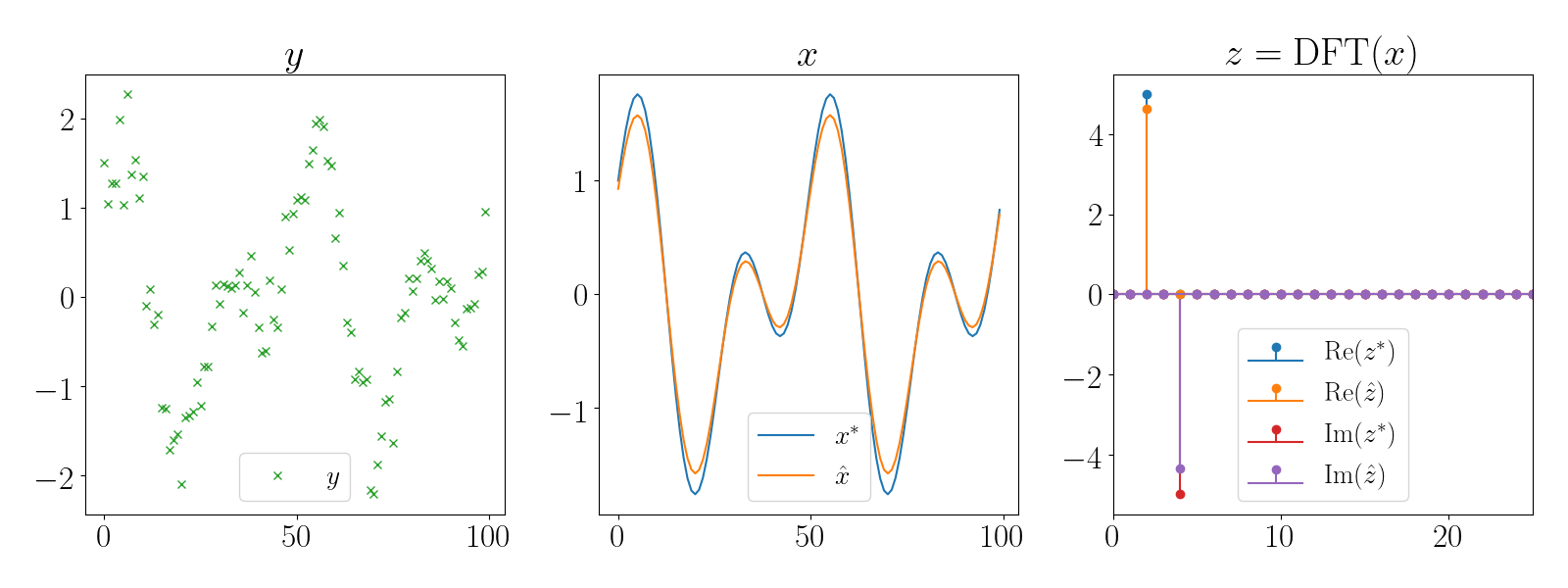Note
Click here to download the full example code
Sparse FFT¶
from tramp.algos import EarlyStoppingEP
from tramp.variables import SISOVariable as V, SILeafVariable as O, MILeafVariable, SIMOVariable
from tramp.channels import DFTChannel, GaussianChannel
from tramp.priors import GaussBernoulliPrior, GaussianPrior
from tramp.experiments import TeacherStudentScenario
import numpy as np
import pandas as pd
import matplotlib.pyplot as plt
from matplotlib import rc
rc('text', usetex=True)
rc('font', family='serif', size=24)
Define a Sparse FFT teacher
class SparseFFT_Teacher():
def __init__(self, N, noise_var):
self.t = np.linspace(-2*np.pi, 2*np.pi, N, endpoint=False)
self.channel = GaussianChannel(var=noise_var)
def sample(self, seed=None):
if seed:
np.random.seed(seed)
x = np.cos(self.t) + np.sin(2*self.t)
z = DFTChannel(real=True).sample(x)
y = self.channel.sample(x)
return {"x": x, "z": z, "y": y}
def info(self):
"Empirical estimates of var(x), var(z) and sparsity of z on a sample"
s = self.sample()
x , z = s["x"], s["z"]
nonzero = (np.abs(z) > 1e-11)
print(
f"On a teacher sample : var(x)={x.var():.3f} "
f"rho(z)={nonzero.mean():.3f} var(z)={z[nonzero].var():.3f}"
)
Define a sparse FFT student
def build_sparse_fft_student(N, prior_var, rho, fft_var, noise_var):
x_shape = (N,)
z_shape = (2, N)
student = (
GaussianPrior(size=x_shape, var=prior_var) @
SIMOVariable(id="x", n_next=2) @ (
GaussianChannel(var=noise_var) @ O("y") + (
DFTChannel(real=True) +
GaussBernoulliPrior(size=z_shape, var=fft_var, rho=rho)
) @
MILeafVariable(id="z", n_prev=2)
)
).to_model()
return student
Plotting function
def plot_sparse_fft(scenario):
fig, axes = plt.subplots(1, 3, figsize=(16, 6))
axes[0].plot(scenario.observations["y"], 'C2x', label=r'$y$')
axes[0].set_title(r'$y$')
axes[1].plot(scenario.x_true["x"], label=r'$x^*$')
axes[1].plot(scenario.x_pred["x"], label=r'$\hat{x}$')
axes[1].set_title(r'$x$')
axes[2].stem(
scenario.x_true["z"][0], label=r"$\textrm{Re}(z^*)$",
markerfmt="C0o", linefmt="C0-", basefmt="C0", use_line_collection=True
)
axes[2].stem(
scenario.x_pred["z"][0], label=r"$\textrm{Re}(\hat{z})$",
markerfmt="C1o", linefmt="C1-", basefmt="C1", use_line_collection=True
)
axes[2].stem(
scenario.x_true["z"][1], label=r"$\textrm{Im}(z^*)$",
markerfmt="C3o", linefmt="C3-", basefmt="C3", use_line_collection=True
)
axes[2].stem(
scenario.x_pred["z"][1], label=r"$\textrm{Im}(\hat{z})$",
markerfmt="C4o", linefmt="C4-", basefmt="C4", use_line_collection=True
)
axes[2].set_title(r'$z = \textrm{DFT}(x)$')
axes[2].set_xlim(0, 25)
for axe in axes:
axe.legend(fancybox=True, shadow=False, loc="lower center", fontsize=20)
fig.tight_layout()
Parameters
N, rho, noise_var, seed = 100, 0.02, 0.1, 1
prior_var, fft_var = 1, 18.75
We create the teacher student scenario
teacher = SparseFFT_Teacher(N, noise_var)
teacher.info()
student = build_sparse_fft_student(N, prior_var, rho, fft_var, noise_var)
scenario = TeacherStudentScenario(teacher, student, x_ids=["x", "z"])
scenario.setup(seed=seed)
Out:
On a teacher sample : var(x)=1.000 rho(z)=0.020 var(z)=18.750
Run EP
_ = scenario.run_ep(
max_iter=1000, damping=0.1, callback=EarlyStoppingEP(tol=1e-2)
)
Plot
plot_sparse_fft(scenario)

Total running time of the script: ( 0 minutes 0.642 seconds)